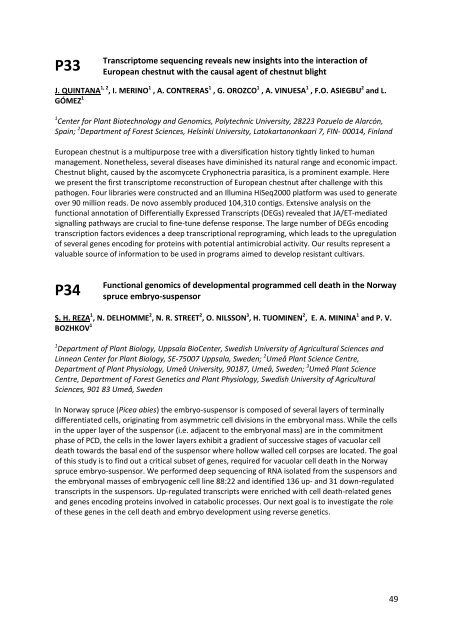Create successful ePaper yourself
Turn your PDF publications into a flip-book with our unique Google optimized e-Paper software.
P33<br />
Transcriptome sequencing reveals new insights into the interaction of<br />
European chestnut with the causal agent of chestnut blight<br />
J. QUINTANA 1, 2 , I. MERINO 1 , A. CONTRERAS 1 , G. OROZCO 1 , A. VINUESA 1 , F.O. ASIEGBU 2 and L.<br />
GÓMEZ 1<br />
1 Center for Plant Biotechnology and Genomics, Polytechnic University, 28223 Pozuelo de Alarcón,<br />
Spain; 2 Department of Forest Sciences, Helsinki University, Latokartanonkaari 7, FIN- 00014, Finland<br />
European chestnut is a multipurpose tree with a diversification history tightly linked to human<br />
management. Nonetheless, several diseases have diminished its natural range and economic impact.<br />
Chestnut blight, caused by the ascomycete Cryphonectria parasitica, is a prominent example. Here<br />
we present the first transcriptome reconstruction of European chestnut after challenge with this<br />
pathogen. Four libraries were constructed and an Illumina HiSeq2000 platform was used to generate<br />
over 90 million reads. De novo assembly produced 104,310 contigs. Extensive analysis on the<br />
functional annotation of Differentially Expressed Transcripts (DEGs) revealed that JA/ET-mediated<br />
signalling pathways are crucial to fine-tune defense response. The large number of DEGs encoding<br />
transcription factors evidences a deep transcriptional reprograming, which leads to the upregulation<br />
of several genes encoding for proteins with potential antimicrobial activity. Our results represent a<br />
valuable source of information to be used in programs aimed to develop resistant cultivars.<br />
P34<br />
Functional genomics of developmental programmed cell death in the Norway<br />
spruce embryo-suspensor<br />
S. H. REZA 1 , N. DELHOMME 2 , N. R. STREET 2 , O. NILSSON 3 , H. TUOMINEN 2 , E. A. MININA 1 and P. V.<br />
BOZHKOV 1<br />
1 Department of Plant Biology, Uppsala BioCenter, Swedish University of Agricultural Sciences and<br />
Linnean Center for Plant Biology, SE-75007 Uppsala, Sweden; 2 Umeå Plant Science Centre,<br />
Department of Plant Physiology, Umeå University, 90187, Umeå, Sweden; 3 Umeå Plant Science<br />
Centre, Department of Forest Genetics and Plant Physiology, Swedish University of Agricultural<br />
Sciences, 901 83 Umeå, Sweden<br />
In Norway spruce (Picea abies) the embryo-suspensor is composed of several layers of terminally<br />
differentiated cells, originating from asymmetric cell divisions in the embryonal mass. While the cells<br />
in the upper layer of the suspensor (i.e. adjacent to the embryonal mass) are in the commitment<br />
phase of PCD, the cells in the lower layers exhibit a gradient of successive stages of vacuolar cell<br />
death towards the basal end of the suspensor where hollow walled cell corpses are located. The goal<br />
of this study is to find out a critical subset of genes, required for vacuolar cell death in the Norway<br />
spruce embryo-suspensor. We performed deep sequencing of RNA isolated from the suspensors and<br />
the embryonal masses of embryogenic cell line 88:22 and identified 136 up- and 31 down-regulated<br />
transcripts in the suspensors. Up-regulated transcripts were enriched with cell death-related genes<br />
and genes encoding proteins involved in catabolic processes. Our next goal is to investigate the role<br />
of these genes in the cell death and embryo development using reverse genetics.<br />
49



